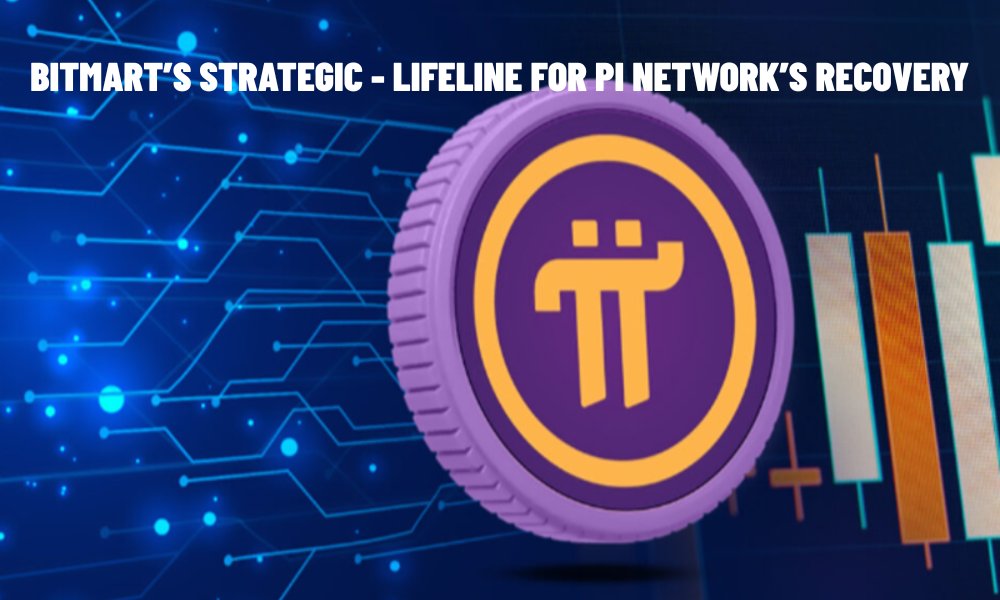Pi Network, grappling with an 80% price drop from its $3 peak, finds a glimmer of hope as BitMart resumes trading after a month-long suspension. This article explores how BitMart’s actions could spark Pi’s recovery, the challenges ahead, and what investors need to know to navigate this volatile crypto landscape.
Pi Network, a mobile-based cryptocurrency project launched in 2019, has faced a turbulent journey since its Open Network debut in February 2025. Once hailed as a revolutionary platform allowing users to mine tokens via smartphones, Pi has seen its price plummet nearly 80% from a high of $3, recently trading around $0.63.
This sharp decline, coupled with community concerns over transparency and delays in ecosystem development, has cast doubts on Pi’s long-term viability. However, a recent move by BitMart, a prominent global crypto exchange, offers a potential lifeline. By resuming Pi trading after a month-long suspension pending Know Your Business (KYB) approval, BitMart has reignited optimism among Pi’s dedicated “Pioneer” community, signaling a possible turning point for the embattled token.

BitMart’s decision to reinstate Pi trading, as reported on April 28, 2025, follows a period of uncertainty for the project. The exchange, registered in the Cayman Islands and licensed as a Money Services Business by the U.S. Financial Crimes Enforcement Network (FinCEN), had paused Pi transactions to comply with KYB requirements, a process aimed at verifying the legitimacy of businesses handling crypto assets.
Posts on X suggest that BitMart’s resumption of trading hints at an imminent KYB approval from Pi’s core team, a development that could restore confidence and boost liquidity. This move comes at a critical juncture, as Pi has struggled with reduced trading volume and limited fiat on-ramps after Banxa, a major fiat-to-crypto provider, temporarily suspended Pi transactions for similar KYB reasons.
The significance of BitMart’s action lies in its potential to stabilize Pi’s market presence. With a daily trading volume exceeding $1.7 billion and a reputation for supporting diverse cryptocurrencies, BitMart is a top-tier platform capable of driving significant exposure. Its decision to resume trading could attract new investors and encourage existing holders to re-engage, potentially reversing Pi’s downward trajectory.
Moreover, BitMart’s global reach, supported by its multilingual interface including Vietnamese, makes it accessible to Pi’s strong user base in countries like Vietnam, China, and South Korea, where the project has cultivated millions of nodes. This renewed accessibility could amplify Pi’s adoption, particularly in regions where businesses are increasingly accepting Pi for real-world transactions, such as restaurants and retail stores in China.
Yet, Pi Network’s path to recovery is fraught with challenges. The project has faced persistent criticism over its opaque blockchain technology and lack of a verifiable whitepaper, raising red flags among analysts. Unlike established cryptocurrencies like Bitcoin or Ethereum, which rely on transparent, open-source code, Pi’s closed ecosystem and referral-based growth model have drawn comparisons to multi-level marketing schemes.

A 2023 warning from Vietnam’s Cybersecurity and High-Tech Crime Prevention Department highlighted risks of data privacy breaches and unregulated transactions, urging caution among investors. More recently, a 90% drop in CoinMarketCap’s community sentiment score in March 2025 fueled speculation of bot-driven manipulation, further eroding trust.
Despite these hurdles, BitMart’s involvement could catalyze positive momentum. The exchange’s robust security measures, built on Google Cloud infrastructure, and its track record of avoiding major hacks provide a stable platform for Pi trading. Additionally, BitMart’s trading campaigns, such as sharing 10,000 USDT worth of tokens, could incentivize participation and boost Pi’s visibility. Analysts note that if Pi sustains trading above the $1.50 resistance level, it could signal a bullish reversal, potentially pushing prices toward $2 or higher. This optimism is tempered by technical indicators, with Pi’s Relative Strength Index (RSI) at 52.67 and a weak MACD crossover suggesting that any recovery may be gradual.
For investors, BitMart’s move underscores the importance of due diligence. Pi’s real-world utility, evidenced by growing merchant adoption in China, offers hope, but its lack of major exchange listings—Binance has repeatedly denied rumors of listing Pi—limits its liquidity. The project’s recent integration with Chainlink, enabling smart contract functionality, and the launch of .pi domain names for its ecosystem signal progress, but these developments must translate into tangible value. Investors should secure their accounts with two-factor authentication, verify official Pi and BitMart channels, and monitor updates from the Pi Core Team to avoid scams, as seen in past incidents like the $HCC hack.
Looking ahead, BitMart’s renewed support could be a pivotal step for Pi Network, but its recovery hinges on broader ecosystem growth and transparency. As the crypto market navigates regulatory shifts and institutional adoption, Pi’s ability to deliver on its promise of a decentralized digital economy will determine its fate. For now, BitMart’s platform offers a stage for Pi to rebuild trust and momentum. Investors and Pioneers alike should stay vigilant, research thoroughly, and seize this moment to engage with a project that, despite its challenges, still holds transformative potential.
